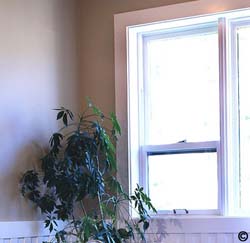Light is important to successfully grow plants indoors. It is needed to produce carbohydrates or food energy for plants. As a rule of thumb, the more light a plant receives, the more carbohydrates are produced. Carbohydrates are stored by the plant and used during low-light periods.
Light intensity refers to the amount of light reaching a plant and is measured in foot-candles. Plants have differing requirements for light intensity. Some perform best under high light levels, while other plants prefer lower levels. High light intensity is considered to be 1000 or more foot-candles, medium is 500 to 1000 and low is 50 to 500. Few plants can tolerate light intensities below 50 foot candles.

High light intensity occurs within two feet of south-facing windows from October through March and within two feet of east or west-facing windows all year. These locations have at least four to six hours of daily sun. Medium light occurs within two feet of north-facing glass from April through September and two to six feet back or one foot to the side of an east or west-facing window. Typically, ten to fourteen hours per day of fluorescent office lighting is considered medium light.
Low light is found within two feet of north-facing glass from October through March and 2 to 6 feet back from, or 1 foot to the side of south-facing glass from April through September. Six to 10 feet back from, or 1 foot to the side of south-facing glass from April through September is considered low light. By moving plants to appropriate locations within the home, any number of light intensities can be achieved.
Avoid placing plants so that foliage is touching glass or cold winter and hot summer temperatures can both be damaging.
Consider artificial light when light levels are too low. By harnessing recent advances in LED technology, LED-based grow lights can deliver significant benefits compared to outdated HID type lights (high pressure sodium or metal halide):
- Up to 50% less power
- Virtually no heat signature
Plants that grow well in high light include: amaryllis, avocado, bromeliads or members of the citrus family. Medium light plants include: African violets, coleus, weeping figs and orchids. Low light choices are cast iron plant, spider plant, piggy-back plant, fittonia and some ferns.
For more information, see the following Planttalk Colorado™ video(s).
For more information, see the following Planttalk Colorado™ script(s).
- Amaryllis
- Avocado
- Houseplants: Artificial Light
- Norfolk Island pine
- Philodendron
- Schefflera
- Christmas Cactus
- Croton
For more information, see the following Colorado State University Extension fact sheet(s).



